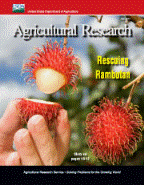United States Department of Agriculture: Agricultural Research Service, Lincoln, Nebraska

Agricultural Research Magazine
Date of this Version
5-2013
Document Type
Article
Citation
Agricultural Research May/June 2013
Abstract
Nearly 85 percent of seafood enjoyed by U.S. consumers is imported, and almost half of that is farm raised through a process called “aquaculture,” according to the National Aquaculture Association, based in Pine Bluff, Arkansas. In 2011, the United States imported $16.6 billion of seafood and exported $5.4 billion, a difference of $11.2 billion.
As the world’s population grows and demand for seafood increases, many seafood species are overfished or fully exploited. That means the world’s oceans cannot turn out more fish than are currently being produced. As the ceiling is being reached on seafood availability from the wild, U.S. producers of farm-raised seafood are working hard to help fill today’s growing demand for seafood in a sustainable way. Aquaculture is a process for raising aquatic species—both marine and freshwater—in a captive environment under controlled conditions.
Salmon: A Great Catch for Nutrition
Agricultural Research Service scientists at the Grand Forks [North Dakota] Human Nutrition Research Center (GFHNRC) conducted studies involving one popular U.S. farmed fish, Atlantic salmon. They wanted to learn more about the omega-3 fatty acids in the fish.
Two omega-3 fatty acids, EPA (eicosapentaenoic acid) and DHA (docosahexaenoic acid), are abundant in oily fish such as salmon, tuna, mackerel, and herring. Some data has shown that consuming 250 milligrams of EPA and DHA—the amount in less than 3 calories of polyunsaturated fatty acids (PUFAs) per day—is associated with reduced heart-disease risk.
Included in
Agriculture Commons, Animal Sciences Commons, Food Science Commons, Plant Sciences Commons

